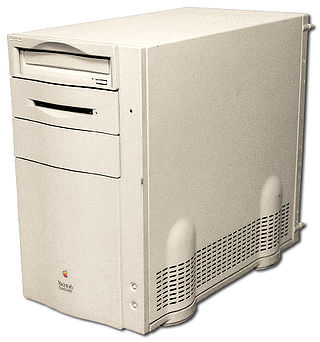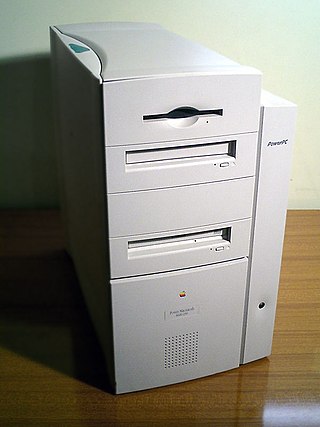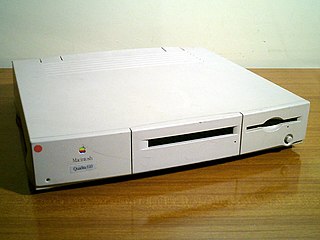
The Power Macintosh, later Power Mac, is a family of personal computers designed, manufactured, and sold by Apple Computer, Inc as the core of the Macintosh brand from March 1994 until August 2006.

The Power Macintosh 8500 is a personal computer designed, manufactured and sold by Apple Computer from August 1995 to February 1997. Billed as a high-end graphics computer, the Power Macintosh 8500 was initially released with a 120 MHz PowerPC 604, and unlike earlier Power Macintosh machines, the CPU was mounted on an upgradeable daughtercard. Though slower than the 132 MHz Power Macintosh 9500, the first-generation 8500 featured several audio and video in/out ports not found in the 9500. In fact, the 8500 incorporated near-broadcast quality (640×480) A/V input and output and was the first personal computer to do so, but no hard drive manufactured in 1997 could sustain the 18 MB/s data rate required to capture video at that resolution. Later, special "AV" hard drives were made available that could delay thermal recalibration until after a write operation had completed. With special care to minimize fragmentation, these drives were able to keep up with the 8500's video circuitry.

The Power Macintosh G3 is a series of personal computers designed, manufactured, and sold by Apple Computer from November 1997 to August 1999. It represented Apple's first step towards eliminating redundancy and complexity in the product line by replacing eight Power Macintosh models with three: Desktop and Mini Tower models for professional and home use, and an all-in-one model for education. The introduction of the Desktop and Mini Tower models coincided with Apple starting to sell build-to-order Macs directly from its web site in an online store, which was unusual for the time as Dell was the only major computer manufacturer doing this. Apple's move to build-to-order sales of the Power Macintosh G3 also coincided with the acquisition of Power Computing Corporation, which had been providing telephone sales of Macintosh clones for more than two years.

The Power Mac G4 is a series of personal computers designed, manufactured, and sold by Apple Computer from 1999 to 2004 as part of the Power Macintosh line. Built around the PowerPC G4 series of microprocessors, the Power Mac G4 was marketed by Apple as the first "personal supercomputers", reaching speeds of 4 to 20 gigaFLOPS. This was the first existing Macintosh product to be officially shortened as "Mac", and is the last Mac able to boot into classic Mac OS with the introduction of MacOS X.

A processor direct slot (PDS) is a slot incorporated into many older Macintosh models that allowed direct access to the signal pins of a CPU, similar to the functionality of a local bus in PCs. This would result in much higher speeds than having to go through a bus layer, such as NuBus, which typically ran at a slower 10 MHz speed.

The Macintosh Quadra 950 is a personal computer designed, manufactured and sold by Apple Computer from March 1992 to October 1995. It replaced the Quadra 900 that was introduced several months earlier, increasing the CPU clock rate of its 68040 CPU from 25 MHz to 33 MHz, and improving the graphics support. The two computers were otherwise identical, including the price. With a Macintosh Processor Upgrade Card installed, this computer is known as the Power Macintosh 950.

The Power Macintosh 6100 is a personal computer designed, manufactured and sold by Apple Computer from March 1994 to March 1996. It is the first computer from Apple to use the new PowerPC processor created by IBM and Motorola. The low-profile ("pizza-box") case was inherited from the Centris/Quadra 610 and 660AV models, and replaced the Macintosh Quadra series that used the Motorola 68040 processor, Apple's previous high-end workstation line.
The Apple Network Server (ANS) was a line of PowerPC-based server computers designed, manufactured and sold by Apple Computer, Inc. from February 1996 to April 1997. It was codenamed "Shiner" and originally consisted of two models, the Network Server 500/132 and the Network Server 700/150, which got a companion model, the Network Server 700/200 with a faster CPU in November 1996.

The Power Macintosh 9500 is a personal computer designed, manufactured and sold by Apple Computer from June 1995 to February 1997. It is powered by a PowerPC 604 processor, a second-generation PowerPC chip which is faster than the PowerPC 601 chip used in the Power Macintosh 8100. The 180MP and 200 MHz models, introduced August 1996, use the enhanced PowerPC 604e processor.

The Macintosh Quadra 800 is a personal computer that is a part of Apple Computer's Quadra series of Macintosh computers.

The Power Macintosh 8100 is a personal computer that is a part of Apple Computer's Power Macintosh series of Macintosh computers. It was introduced in March 1994 alongside the Power Macintosh 6100 and the 7100 as the high end model of the first generation of the Power Macintosh family, and is a direct replacement of the prior Macintosh Quadra 800. It retains the Quadra 800's enclosure.

The Power Macintosh 6200 is a series of personal computers designed, manufactured, and sold by Apple Computer from May 1995 to July 1997. The 6200 is the PowerPC-based replacement for the Quadra 630, with the same form factor and price range. In early 1997, the rather different Power Macintosh 6300/160 / Performa 6360 based on the Power Macintosh 6400 was introduced. The whole line was discontinued when the desktop model of the Power Macintosh G3 was released.

The Power Macintosh 8600 is a personal computer designed, manufactured, and sold by Apple Computer from February 1997 to February 1998. It was introduced alongside the Power Macintosh 7300 and 9600 with a 200 MHz PowerPC 604e processor, and comes in a new case design that replaces the widely-disliked Quadra 800-based form factor of its predecessor, the Power Macintosh 8500.

The Power Macintosh 7300 is a personal computer designed, manufactured and sold by Apple Computer from February 1997 to November 1997. It was introduced with 166, 180 and 200 MHz CPUs in February 1997 alongside the Power Macintosh 8600 and 9600. The 7300 replaced both the Power Macintosh 7200 and 7600, replacing the only remaining first-generation PowerPC system in Apple's lineup.

The Power Macintosh 7200 is a personal computer designed, manufactured, and sold by Apple Computer from August 1995 to February 1997. The 90 MHz model was sold in Japan as the Power Macintosh 7215, and the 120 MHz model with bundled server software as the Apple Workgroup Server 7250. When sold as the 8200, it used the Power Mac 8500's mini-tower form factor.

The Macintosh Quadra 610, originally sold as the Macintosh Centris 610, is a personal computer designed, manufactured and sold by Apple Computer from February 1993 to July 1994. The Centris 610 was introduced alongside the larger Centris 650 as the replacement for the Macintosh IIsi, and it was intended as the start of the new midrange Centris line of computers. Later in 1993, Apple decided to follow an emerging industry trend of naming product families for their target customers – Quadra for business, LC for education, and Performa for home – and folded the Centris 610 into the Quadra family.

The Power Macintosh 5260 is a personal computer designed, manufactured and sold by Apple Computer, Inc. from April 1996 to March 1997. It is a replacement for the Power Macintosh 5200 LC, retaining its all-in-one form factor while replacing its PowerPC 603 CPU with the newer and faster PowerPC 603e, and dropping the "LC" brand. As was standard practice at the time for Apple, the 5260 was re-branded as a number of Performa models and sold to consumer markets, while the 5260 itself was primarily sold to the North American education market as a Power Macintosh.

The Power Macintosh 5500 is a personal computer designed, manufactured, and sold by Apple Computer from February 1997 to March 1998. Like the Power Macintosh 5260 and 5400 that preceded it, the 5500 is an all-in-one design, built around a PowerPC 603ev processor operating at 225, 250 or 275 megahertz (MHz).
The Power Macintosh 5400 is a personal computer designed, manufactured and sold by Apple Computer from April 1996 to March 1998. The 5400 is an all-in-one computer with an integrated monitor, and replaced the Power Macintosh 5200 LC in that role. It is largely identical to the Power Macintosh 6400 internally, which is essentially the same computer in a tower case. This is the first all-in-one Macintosh to support PCI expansion, replacing the Processor Direct Slot.

The Power Macintosh 6400 is a personal computer designed, manufactured and sold by Apple Computer from August 1996 to August 1997. It is the only Macintosh mini-tower system to be branded as a Performa, and alongside the Performa 6360 was the last new Performa-branded model introduced by Apple.





















